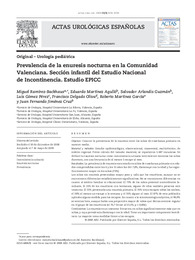Please use this identifier to cite or link to this item:
https://hdl.handle.net/11000/35072Full metadata record
| DC Field | Value | Language |
|---|---|---|
| dc.contributor.author | ramirez backhaus, miguel | - |
| dc.contributor.author | Martínez Agulló, Eduardo | - |
| dc.contributor.author | Arlandis Guzmán, Salvador | - |
| dc.contributor.author | Gómez-Pérez, Luis | - |
| dc.contributor.author | Delgado Oliva, Francisco | - |
| dc.contributor.author | Martínez García, Roberto | - |
| dc.contributor.author | Jiménez, Juan Fernando | - |
| dc.contributor.other | Departamentos de la UMH::Medicina Clínica | es_ES |
| dc.date.accessioned | 2025-01-21T09:17:12Z | - |
| dc.date.available | 2025-01-21T09:17:12Z | - |
| dc.date.created | 2009-05-07 | - |
| dc.identifier.citation | Actas Urol Esp . 2009 Oct;33(9):1011-8 | es_ES |
| dc.identifier.issn | 0210-4806 | - |
| dc.identifier.uri | https://hdl.handle.net/11000/35072 | - |
| dc.description.abstract | Objetivo: Conocer la prevalencia de la enuresis entre los niños de enseñanza primaria en nuestro medio. Material y métodos: Estudio epidemiológico, observacional, transversal, multicéntrico, de ámbito regional. Previo cálculo del tamaño muestral, se repartieron 1.687 encuestas. Se definió la enuresis nocturna como incontinencia urinaria intermitente mientras los niños duermen, con una frecuencia de al menos 1 escape al mes. Resultados: La prevalencia de enuresis encontrada en niños de enseñanza primaria con edades comprendidas entre los 6 y los 11 años fue del 7,8%, disminuye con la edad y fue significativamente mayor en los niños (70%). Los niños sin enuresis presentaban mayor peso y talla que los enuréticos, aunque no se encontraron diferencias estadísticamente significativas. No se encontraron diferencias en cuanto al ámbito familiar ni educacional. El 73% de los niños presentó antecedentes familiares. El 21% de los enuréticos con hermanos, alguno de ellos también presenta este trastorno. El 55% presentaba una enuresis primaria. El 31% tenía escapes todas las noches, el 38% al menos un escape a la semana y el 31% alguno al mes. El 87% de esta población aplicaba alguna medida para los escapes. En cuanto a la sintomatología subjetiva, el 96,9% se sentían bien, aunque había una proporción mayor de niños que decían sentirse regular en el grupo de los enuréticos (el 76,7 frente al 23,1%; p = 0,004). Conclusiones: La enuresis es un trastorno frecuente, en niños significativamente más que en niñas, y cuya prevalencia disminuye con la edad. Tiene un importante componente hereditario. La mayoría toma medidas frente a los escapes. | es_ES |
| dc.description.abstract | Objective: To ascertain the prevalence of enuresis among primary school children in Spain. Materials and methods: A multicenter, observational, cross-sectional, epidemiologic, regional study. After sample size calculation, a total of 1687 questionnaires were sent to schools. Nocturnal enuresis was defined as «loss of urine occurring during sleep, at least once a month». Results: The prevalence of enuresis found in primary school children aged 6-11 years was 7.8%, decrease with age, and was significantly greater in boys (70%). Children without enuresis were taller and had a greater weight than those with enuresis, but the differences were not statistically significant. No differences were found in the family or educational setting between children with and without enuresis. Seventy-three percent of children with enuresis had a family history of the condition. The disorder also occurred in some sibling of 21% of children with enuresis who had siblings. Fifty-five percent of the bedwetting population had primary enuresis. Thirty-one percent of children with enuresis reported losses every night, 38% at least once a week, and 31% at least once a month. Eighty-seven percent of this population was under treatment for this condition. As regards subjective symptoms, 96.9% said they felt fine, but there were more bedwetting children who reported feeling a little bit uncomfortable (76.7% vs 23.1%; P=.004). Conclusions: Enuresis is a common disorder which is significantly more frequent in boys as compared to girls and whose prevalence decreases with age. It has a significant hereditary component. Most enuresis sufferers take measures against urine losses. | es_ES |
| dc.format | application/pdf | es_ES |
| dc.format.extent | 8 | es_ES |
| dc.language.iso | spa | es_ES |
| dc.publisher | Elsevier | es_ES |
| dc.rights | info:eu-repo/semantics/openAccess | es_ES |
| dc.rights | Attribution-NonCommercial-NoDerivatives 4.0 Internacional | * |
| dc.rights.uri | http://creativecommons.org/licenses/by-nc-nd/4.0/ | * |
| dc.title | Prevalencia de la enuresis nocturna en la Comunidad Valenciana. Sección infantil del Estudio Nacional de Incontinencia. Estudio EPICC | es_ES |
| dc.title.alternative | Prevalence of nocturnal enuresis in the Valencian Community. Pediatric section of the National Incontinence Survey. The EPICC Study | es_ES |
| dc.type | info:eu-repo/semantics/article | es_ES |
| dc.relation.publisherversion | 10.1016/s0210-4806(09)72902-x | es_ES |

Ver/Abrir:
Prevalencia de la enuresis nocturna en la Comunidad.pdf
187,17 kB
Adobe PDF
Compartir:
 La licencia se describe como: Atribución-NonComercial-NoDerivada 4.0 Internacional.
La licencia se describe como: Atribución-NonComercial-NoDerivada 4.0 Internacional.
.png)